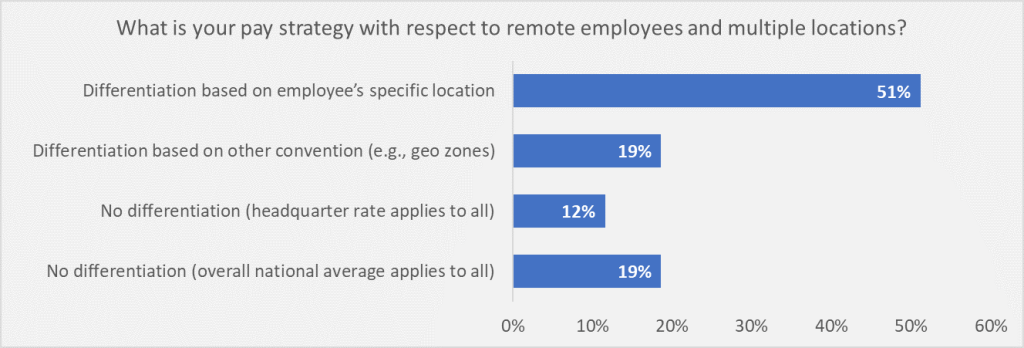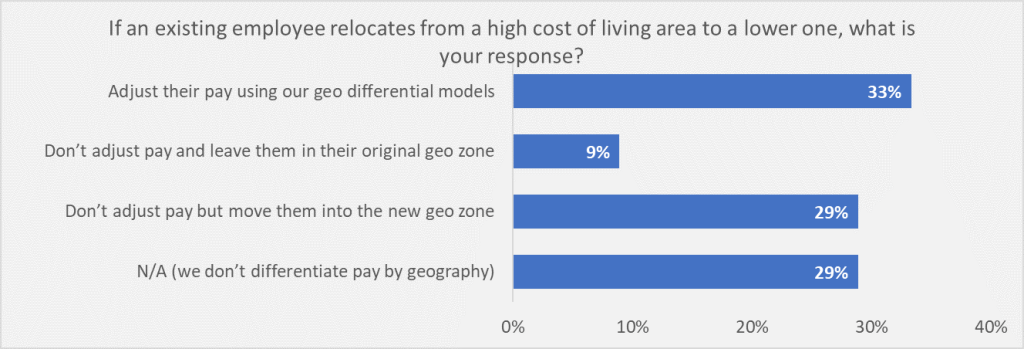Equity Methods Survey Reveals Contemporary Trends in Pay Equity
In the last few years, we’ve published extensively on pay equity and the ingredients of a successful pay equity study. (If you haven’t requested a copy of our comprehensive FAQ booklet, you can do so here.)
But over the course of 2022, our interest has turned to the way unprecedented events in the labor market are influencing and disrupting pay equity efforts. A red-hot talent market, the Great Resignation, and the rapid emergence of new roles have forced companies to make pay decisions that are categorically more aggressive, with many of these decisions occurring during periods of high business turmoil and urgency. Most of these decisions stem purely from business and market needs. Still, there’s a growing concern that they might lead to, or exacerbate, pay inequities in the organization.
In our experience, pay inequity can result from many conditions, including (but not limited to) general turbulence in employee entry and exit. We presented on these topics at the WorldatWork Rewards Conference in May and our own webcast in June. During our webcast, we polled participants to learn how they have approached a handful of contemporary issues and challenges. We’re pleased to report the results here.
About the Data
Seventy-two companies participated in our webcast poll. Most have over 500 employees. They span multiple industries, with a slight clustering in technology, financial services, retail, and life sciences.
By now, most public and large private companies have conducted some form of pay equity study. Some are now analyzing root causes and related areas of potential bias (like promotion equity). Those just beginning their journey are improving their techniques and creating clear visualizations of the results for management and the board. (Contact us if you’d like to discuss program management and how your current process aligns with market best practices.)
Now let’s look at the polling results and what they suggest for continuous improvement in pay equity management.
Q1: Pay Negotiation Differences
The issue: Some of the literature on pay equity suggests that males, on average, negotiate more frequently and aggressively at the offer table versus women. Similar dynamics may also play out among different ethnicities.
Poll question and answers: We asked respondents how their hiring practices address negotiation and what protocols exist to mitigate the risk of males negotiating harder than females. A majority of respondents state they maintain real-time tools to limit concessions.
Our perspective: Real-time tools to test negotiation tolerance vary in form and function. But they all aim to create the equivalent of bumpers in a bowling lane to keep pay within range. Although it sounds simple, imprecise job architectures, a lack of market benchmarking data, and a proliferation of new roles make this harder to maintain in practice. The emerging best practice is to layer the most recent results of the pay equity study into these tools to connect decision-making with pay equity monitoring.
One solution we’ve been exploring with clients is to transfer the results of their annual pay equity study into a dynamic tool our clients can use during real-time negotiations. For instance, users can enter job details and receive a guideline pay range (based on the statistical model developed earlier during the pay equity study). The model also shows the range of actual employee pay data for individuals in similar roles. Finally, if the data is available, users can see how the pay for each role benchmarks against similar roles in the market.
This approach helps to:
- Avoid inequity replication. Since pay range is linked to the pay equity study of the existing employee population, the model mitigates the risk of creating new inequities that will need to be addressed during the next year’s pay equity analysis.
- Connect existing employees to new hires. In red-hot talent markets, it’s easy for new hires to leapfrog existing employees or for pay compression to disproportionately harm tenured employees.
- Identify employees who need a pay correction. Since you may need to exceed pay ranges to lock in critical new talent, the tool quantifies potential pay adjustments that may be appropriate for existing and similarly situated employees.
Q2: Responsive Retention Action
The issue: Responsive retention action is when companies dip into a separate budget to make a counteroffer to an employee who’s planning to quit. This could be a base salary adjustment, retention bonus, retention equity grant, or something entirely different. Not all companies engage in responsive retention. Some are more proactive, giving high performers or retention risks a retention grant before they get another offer.
Like new hire pay, responsive retention can be discretionary and subject to negotiation, and therefore introduce pay inequity. Even without negotiation, responsive retention can materially alter existing pay relationships among employees who are similarly situated otherwise.
Poll question and answers: We asked survey respondents if they incorporate responsive retention decisions into their pay equity studies. The reason this is an interesting question is that some believe employees quit for market reasons (e.g., they’re leaving a role that pays below market rate for a similar role elsewhere that pays at market rate) and is therefore a valid factor that ought to explain pay.
If this is true, then it could be argued that pay equity studies don’t need to include responsive retention. However, market pressure and competitive offers aren’t observable across the entire employee population—only some small subgroup that presents their intention of leaving. This raises questions as to how and whether you should include these pay decisions in pay equity assessments.
Forty-one percent of respondents say they include responsive retention decisions in their pay equity modeling exercises. The reason is that pay is pay, whether an incremental amount to keep someone from leaving or just normal pay decided during the annual merit cycle. An identical share of respondents say they don’t include responsive retention actions into their pay equity studies, though for different reasons.
Our perspective: We can appreciate both sides of the responsive retention debate.
The right answer may come down to the purpose of the pay equity analysis. If it’s to quantify aggregate pay inequities based on gender or ethnicity differences, or create a proactive legal defense, then it’s critical to include discretionary retention bonuses. Otherwise, the organization won’t get an accurate picture of its pay equity status. Besides that, some states specifically mandate that all forms of compensation must be included in the analysis.
On the other hand, if the purpose of the pay equity study is to identify outlier employees who require adjustments to base salary, then including retention bonuses may muddy the analysis. At a minimum, we recommend running the models with and without responsive retention actions so you can see how these decisions affect pay equity.
During our webcast, a few attendees asked how to handle retention equity grants since these have multi-year vesting periods. The most accurate way is to convert a multi-year retention bonus or equity grant to an annualized figure based on the percent vesting in the current year (which also means including the outstanding portion of retention bonuses issued in prior years). But this can be hard to do, given timing differences on when these retention bonuses occur.
Q3: Remote Employees and Working Locations
The issue: The debate over geographical pay differentiation has been going on for years, but heated up during Covid-19. The question is basically whether an employee in an area with a relatively low cost of living ought to be paid the same as a peer in an area with a high cost of living.
Poll question and answers: We asked respondents how they handle pay based on differing working locations.
A majority state they vary pay based on an employee’s specific location. Another 19% say they vary pay based on a different convention, such as geographical zones (e.g., the headquarters as the baseline zone, followed by a few other zones that introduce pay discounts or premiums based on cost of living or cost labor differences). What we didn’t ask is how significant their pay variation is. Anecdotally, we see some companies applying relatively small differences (e.g., plus or minus 10%) and others trying to track actual cost of living differences.
How do companies that maintain pay differentiation by region deal with mobile or relocated employees? (Think of an engineer who moves from San Francisco to Boise.)
About a third of respondents say they adjust pay using their geographic models. (Again, adjustments at some companies may be minimal.)
Nearly as many respondents say they move the employee into the new geographic zone but leave pay untouched. This could alter the employee’s future compensation because their move may have put them at the top of their new region’s pay band. That engineer from San Francisco who moved to Boise may not get a raise next year.
Our perspective: For a new employee, it’s relatively easier to benchmark pay based on the specific location or geographical zone. But for mobile employees, geographical pay differences could cause a large pay decrease. That’s risky in any talent climate, but especially the present one. At the same time, taking no action could negatively impact pay equity and employee morale. So whether you decide to adjust pay or move these employees to a new geographical zone, practices should be consistent and part of a broader policy.
Q4: Statistical Modeling and Diversity Monitoring
The issue: To monitor diversity, virtually all companies crunch numbers like the percentage of females in managerial roles or the number of non-white employees in executive bands. These simple statistics are essential, but they don’t show whether promotions, hires, and exits are within statistically normal ranges or represent anomalies that cannot be explained by normal factors.
By way of example, suppose 50 employees are promoted into a certain band, with 10 being female and 40 being male. What we don’t know is whether the fact that 20% of the promoted employees are female reflects a bias or is within statistically normal tolerance ranges. Regression modeling could offer some insight.
Poll question and answers: We asked respondents whether they use enhanced techniques for diversity modeling.
Results are mixed and, of course, we didn’t delve into the types of analytics being run on hiring, promotion, and attrition.
Our perspective: We think the next step is to look at equity through many different lenses, not just pay. For our clients, we’re exploring methods for converging pay equity assessments with related questions of entry, exit, and promotion—or what we could call career equity. For example, we’re analyzing different facets of career equity to pinpoint bottlenecks that could lead to pay inequity. Keep an eye on how the science and practice evolve here.
Wrap-Up
The pay equity landscape is rapidly evolving. Indeed, we’re now performing career equity analyses that go beyond just pay. Real-time monitoring is another important development. Although we didn’t discuss it here, root cause analysis is also being used more to help inform remediation strategies.
Look carefully at career equity processes across the organization. While most companies have procedures in place, their quality, comprehensiveness, and usability can vary widely. Ask questions such as:
- Do my CEO and chief people officer understand the results?
- Can we work with our pay equity vendor to implement new enhancements to support continuous improvement efforts?
- Are there broader policy decisions we need to make on topics like responsive retention and new hire pay alignment?
- Do we need additional sponsorship at the board or executive level?
- Are HR business partners and line executives critically engaged?
We look forward to discussing these and any other related questions with you.






